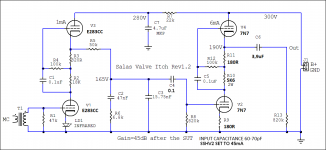Most of those Anti-Riaa circuits are theoretically accurate but to make a practically accurate one with ready to buy parts I think Bonsai's approach is best: http://hifisonix.com/wordpress/wp-content/uploads/2016/12/Accurate-Inverse-RIAA.pdf
Can be used with 600 ohms output impedance of my Lader Lag120B signal generator or have I to mod something?
It can be used without doing something extra but its accuracy will jump from 0.5% to 1.5% (worst case).
Of course its good if you can have the parts accuracy it notes (especially difficult for low nF capacitors)
1% each but anyway since you found a solution for the caps then find 0.1% resistors too and follow Kevin's mod for 600 Ohm source. But is everybody's gen as flat as the anti-riaa will be? A good sound card may more easier be.
1% each but anyway since you found a solution for the caps then find 0.1% resistors too and follow Kevin's mod for 600 Ohm source. But is everybody's gen as flat as the anti-riaa will be? A good sound card may more easier be.
Could you elaborate or give a link to se how to?
The one you draw after Kevin's suggested changes on ECC8010's schematic in that old thread link you provided in #3113
I meant a good sound card can be flatter in the audio band than some cheaper generators maybe
I meant a good sound card can be flatter in the audio band than some cheaper generators maybe
What about the Leader Lag-120A?
https://doc.xdevs.com/doc/Leader/Leader%20LAG-120a%20-%20Manual.pdf
Or don't worth to use it to measure the RIAA?
Says output flatness +/- 0.5dB across 600 Ohm. For general check is alright but don't lose sleep over making a super accurate anti-Riaa to use with it.
Better to use a software + soundcard, right?
I have ARTA (payment version) is OK?
Or use soft + inverse RIAA, what's the best solution?
I have ARTA (payment version) is OK?
Or use soft + inverse RIAA, what's the best solution?
Build your inverse Riaa in good tolerance first and then its usable both with gen and meter/scope as well as with sound card and Arta FR test. Then play with all and decide what's better more accurate or easier good enough method for your phono bench tests.
It will probably let your speakers cones move more with disc anomalies and rumble. Depends on your TT and speakers damping. Unless your C6 and power amp input impedance make a stronger subsonic filter already than what C4 and R8 define.
My preamps have an input impedance of 100K.
Itch preamp 3.9uF & 100K Cut-off frequency fc = 0.4Hz
Itch 0.1uF & 820K Cut-off frequency fc = 1.9Hz
Itch 0.47uF & 820K Cut-off frequency fc = 0.4Hz
No good go higher than 01uF, using V-Cap coupling calculator.
Load Input Impedance (Ohms): 820000
Capacitor Value (µF) 0.1
-3db Frequency (Hz): 1.94
Optimal low frequency response (Hz): 19.41
If used 0.47uF
Load Input Impedance (Ohms): 820000
Capacitor Value (µF) 0.47
-3db Frequency (Hz): 0.41
Optimal low frequency response (Hz): 4.13
So no act as subsonic filter for frecuencies lower than 20Hz
Itch preamp 3.9uF & 100K Cut-off frequency fc = 0.4Hz
Itch 0.1uF & 820K Cut-off frequency fc = 1.9Hz
Itch 0.47uF & 820K Cut-off frequency fc = 0.4Hz
No good go higher than 01uF, using V-Cap coupling calculator.
Load Input Impedance (Ohms): 820000
Capacitor Value (µF) 0.1
-3db Frequency (Hz): 1.94
Optimal low frequency response (Hz): 19.41
If used 0.47uF
Load Input Impedance (Ohms): 820000
Capacitor Value (µF) 0.47
-3db Frequency (Hz): 0.41
Optimal low frequency response (Hz): 4.13
So no act as subsonic filter for frecuencies lower than 20Hz
- Home
- Source & Line
- Analogue Source
- Valve Itch phono


